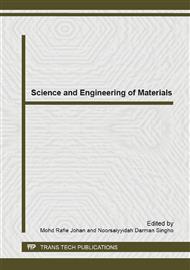[1]
Patcharee Jongnavakit, Pongsaton Amornpitoksuk, Sumetha Suwanboon, Tanakorn Ratana, Surface and photocatalytic properties of ZnO thin film prepared by sol-gel method, Thin Solid Films 520 (2010) 5561-5567.
DOI: 10.1016/j.tsf.2012.04.050
Google Scholar
[2]
Seung Hwangbo, Yun-Ji Lee, Kyu-Seog Hwang, Photoluminescence of ZnO layer on commercial glass substrate prepared by sol-gel process, Ceramic International 34 (2008) 1237-1239.
DOI: 10.1016/j.ceramint.2007.03.014
Google Scholar
[3]
Fawzy A. Mahmoud, G. Kiriakidis, Nanocrystalline ZnO thin film for gas sensor application, Journal of Ovonic Research 5 (2009) 15-20.
Google Scholar
[4]
B.J. Jin, H.S. Woo, S. Im, S.H. Bae, S.Y. Lee, Relationship between photoluminescence and electrical properties of ZnO thin films grown by pulsed laser deposition, Applied Surface Science 169-170 (2001) 521-524.
DOI: 10.1016/s0169-4332(00)00751-0
Google Scholar
[5]
Rajesh Kumar, Neeraj Khare, Vijay Kumar, G. L Bhalla, Effect of intrinsic stress on the optical properties of nanostructured ZnO films grown by rf magnetron sputtering, Applied Surface Science 254 (2008) 6509-6513.
DOI: 10.1016/j.apsusc.2008.04.012
Google Scholar
[6]
J.R. Casnova, E.A. Heredia, C.D. Bojorge, H.R. Canepa, G. Kellermann, A.F. Craievich, Structural characterization of supported nanocrystalline ZnO thin films prepared by dip-coating, Applied Surface Science 257 (2011) 10045-10051.
DOI: 10.1016/j.apsusc.2011.06.136
Google Scholar
[7]
Mujdat Caglar, Saliha Ilican, Yasemin Caglar, Fahrettin Yakuphanoglu, Electrical conductivity and optical properties of ZnO nanostructured thin film, Applied Surface Science 255 (2009) 4491-4496.
DOI: 10.1016/j.apsusc.2008.11.055
Google Scholar
[8]
Kyu-Seong Hwang, Yun-Ji Lee, Seung Hwangbo, Growth, structure and optical properties of amorphous or nano-crystalline ZnO thin films prepared by prefiring-final annealing, Journal of Ceramic Research Vol. 8 No. 5 (2007) 305-311.
Google Scholar
[9]
Kyu-Seo Hwang, Bo-An Kang, Ju-Hyun Jeong, Young-Sun Jeon, Byung-Hoon Kim, Spin coating-pyrolysis derived highly c-axis oriented ZnO layers pre-fired at various temperature, Current Applied Physics 7 (2007) 421-425.
DOI: 10.1016/j.cap.2006.09.016
Google Scholar
[10]
Jin-Hong Lee, Kyung-Hee Ko, Byung-Ok Park, Electrical and optical properties of ZnO transparent conducting films by the sol-gel method, Journal of Crystal Growth 247 (2003) 119-125.
DOI: 10.1016/s0022-0248(02)01907-3
Google Scholar


